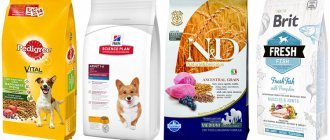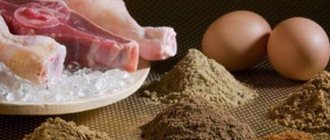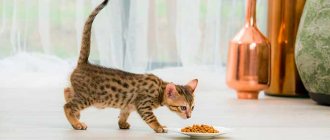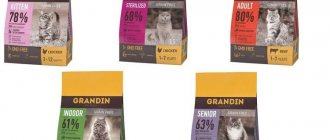Dry or natural: what to choose
Many dog owners, especially newbies, find themselves under information pressure when trying to choose the optimal diet for their dog. Having listened to advertising and advice from experienced dog owners, a novice owner becomes even more confused.
Dry or natural: what to choose? Which food is better and healthier? How do you know if your dog really likes the food?
- Feeding your dog naturally is more natural.
- Dry ready-made food is an alternative for owners who, for some reason, cannot feed their dog suitable natural food.
To be fair, we note that in some situations, feeding industrial products becomes the only alternative to provide your pet with a balanced diet.
So, “natural” or dry food?
The answer to the question of what to feed a dog, “natural” or dry food, depends on a number of factors: the owner’s availability of free time to purchase ingredients and prepare a natural diet, the ability to store and purchase high-quality ingredients, etc. So, with the modern rhythm of life, dry food This is often the only way to provide your pet with balanced and high-quality nutrition. There is only one thing you can definitely say, no matter what type of food you choose, you should take into account the fact that the basis of a dog’s diet should be meat ingredients.
All Blitz foods are meat based
Under the auspices of the Blitz brand, several lines of dry food are produced, which provide balanced nutrition for dogs of all age and breed groups. The Classic series is suitable for chicken lovers; for pets with more sensitive digestion, Blitz offers the Sensitive line, made from turkey and lamb.
The Blitz brand is especially proud of its Holistic series of dry dog food, made in Italy. The range of this line includes both low-grain and grain-free diets with a high content of quality sources of animal protein.
All Blitz diets have a transparent composition, are enriched with vitamin and mineral premixes and a complex of probiotics, and do not contain artificial additives or preservatives. If desired, Blitz dry food can be supplemented with canned food of the same brand.
Natural feeding
Natural feeding implies the most natural diet possible. Feeding with natural products involves three possible options:
- Raw food diet - feeding only raw foods.
- Meat porridge - feeding the dog a balanced mixture of heat-treated products.
- A mixture of raw and cooked foods is the most common type of feeding.
Important! Dogs are very different from their wild relatives and live in unnatural conditions, so the diet must be tailored to their needs.
Pros and cons of a natural diet
Let's look at the pros and cons of natural hair . Let's start with the advantages:
- Control over the freshness and quality of products.
- Taste variety.
- Possibility to control the caloric content of feed.
- The ability to choose a varied, tasty and gentle diet.
Negative nuances:
- Dog food needs to be prepared separately and regularly - time consuming.
- Products for cooking should be as natural as possible, for example, cottage cheese and other fermented milk products should be prepared at home from whole milk.
- Raw meat can become a source of helminth infection and should be cooked or frozen for 4–5 days.
- Natural food spoils quickly.
Note! Even the most balanced natural diet does not provide the dog with all the necessary vitamins and minerals, so the pet needs to take vitamin courses regularly.
Rules for feeding dogs with natural products
The basic rules of feeding natural products are balance. Statistically, most owners prefer to feed their dog meat porridge.
- For adult dogs, meat porridge is prepared from meat and offal, cereals, vegetables and fruits (33% each). Immediately before serving, vitamin supplements are added to the porridge.
- For puppies, the ingredients of porridge are similar, but the mass fraction of meat should be at least 50–60%.
Important! All foods that can cause allergies are introduced into the diet gradually.
There are many myths associated with milk, which is an important part of a dog's diet. Milk can and should be given to a dog if it tolerates it normally. Approximately 40% of adult dogs develop lactose intolerance, in which case whole milk is replaced with fermented milk products.
Prohibited Products
Prohibited foods in a dog’s natural diet are:
- Alcohol and its derivatives.
- Bones, pure fat, skin, especially poultry.
- Fat meat.
- Palm oil.
- Grapes, raisins.
- Citrus.
- Onion and garlic.
- Persimmon.
- Soy.
- Mushrooms.
- Corn and semolina.
- Raw freshwater fish.
- Dry, salted fish.
- Mayonnaise.
- Products containing hops, tobacco, sugar or its substitutes, xylitol (chewing gum, some sweets), flour or yeast (including yeast dough and dishes made from it), caffeine, cocoa, any stimulants (sweets, tea, coffee, chocolate) , marinades, salt, spices.
- Smoked products, including sausages, balyki, fish.
- Expired products.
- Cat food.
- Leftovers from the table.
You need to be careful with:
- Pork is a source of helminths.
- Raw ocean fish are a source of helminths.
- Whole milk – risk of intolerance.
- Honey is allergenic.
- Chicken eggs are allergenic.
- Raw and boiled chicken liver in large quantities can cause constipation or diarrhea (respectively).
Note! Peaches, plums and other juicy fruits are not prohibited, but can cause diarrhea. The bones can become stuck in the intestinal lumen, leading to obstruction.
An example of a proper menu made from natural products
The daily food intake for a puppy is calculated by weight. The weight of all the food that the baby eats per day should be 7–8% of body weight. For example, let's take the age from 1 to 3 months.
Feeding frequency:
- 1 month – 6 times a day.
- 2 months – 5 times a day.
- 3 months – 4 times a day.
Approximate calculation of food per day for a medium breed puppy aged 1–3 months:
- Meat and offal: 100–400 gr. – mass fraction of by-products no more than 15%.
- Cereals (preferably buckwheat, rice): 80–150 gr.
- Raw and boiled vegetables: 120–200 gr.
- Whole milk: 400–500 ml – in case of individual intolerance (extremely rare under the age of 3 months), milk is replaced with fermented milk products.
- Cottage cheese and fermented milk products: 100–200 gr.
- Chicken or quail egg: 1 chicken yolk or 2 quail eggs.
- Oils and additives: no more than 8 ml in total volume.
An example of the correct menu for a puppy aged 1 to 3 months.
- Early morning: cottage cheese with milk, you can add buckwheat cooked in milk.
- Morning: meat porridge - cereals, vegetables (carrots), meat, offal. Meat component 60%.
- Day: milk, cottage cheese, fermented milk products.
- Afternoon snack: meat porridge.
- Evening: milk porridge (buckwheat/rice/oatmeal) with grated apple, maybe a little kefir, yogurt or fermented baked milk.
- Evening: the meat is clean, raw, after deep freezing for 4–5 days.
Adult dogs eat 2-3 times a day.
For a medium-sized pet (25–30 kg), the approximate daily food intake is made up of:
- Meat and offal and/or fish: 400–500 gr. – by-products no more than 10–15%.
- Cereals (rice, buckwheat, oatmeal, pearl barley): 400–500 gr. – the calorie content of cereals is selected according to individual needs, but it is better to give preference to rice and buckwheat.
- Vegetables and fruits: 300–350 gr. – can be given raw, boiled, steamed.
- Chicken or beef fat: up to 20 gr. – can be replaced with fish oil (2-3 capsules).
- Vitamin supplements: 10–15 g. – can be replaced with industrial vitamin supplements in tablets.
Example menu for an adult dog No. 1:
- Morning: meat porridge – 300 gr. meat, 300 gr. cereals, 200–250 gr. vegetables, vitamin supplements.
- Evening: beef stomach, chopped, 200–350 gr.
Example menu for an adult dog No. 2:
- Morning: milk porridge – 250–300 gr. cereals, 1-2 small apples, chicken or 2-3 quail eggs, cottage cheese 100-150 gr.
- Evening: meat porridge – 300 gr. meat, 300 gr. cereals, 200–250 gr. vegetables, vitamin supplements.
Sample menu for an adult dog No. 3:
- Morning: fish and broth with vegetables (except potatoes) 400–550 gr. in total.
- Evening: raw meat or beef tripe 250–200 g, vitamin supplements.
Note! Due to breed characteristics, the above examples may not be suitable for your pet. Always create a diet based on the preferences and behavior of the ward.
To determine whether the dog is eating the offered portion, it is necessary to monitor the pet’s behavior immediately after eating. Typically, the dog actively absorbs food within 10–15 minutes.
- If there is food left in the bowl 20 minutes after the start of the meal, the portion is too large.
- If the dog finished eating in less than 10 minutes, the portion of food is not enough.
Water intake when feeding natural food
With natural feeding, the water norm is calculated based on the pet’s weight. The minimum daily water intake is 50 ml per 1 kg of body weight. Not drinking enough water can lead to problems digesting food and dehydration. Excessive thirst and water consumption is an alarming symptom.
Exceeding the norm of water consumption by 2 or more times, against the background of a good appetite, may indicate the development of diabetes. Strong thirst is also a symptom of purulent inflammation of the uterus and other inflammatory processes.
In any case, if your dog drinks much more water than he should, be sure to consult a doctor.
Cost of feeding dry food
I proceed from the prevailing opinion of many veterinary minds that when feeding dry food, another type of nutrition is unacceptable. That is, we exclude mixed nutrition (“drying” and “natural”).
Manufacturers of dry food claim that they contain all the necessary microelements and vitamin-mineral supplements, so there is no need to feed the animal with natural products or give vitamins.
I will not confirm or refute this postulate, although I have long formed my own opinion regarding feeding dry food.
Let's look at what is cheaper, dry food or natural food using the example of one of the popular premium dry food manufacturers. Let's take Acana Grasslands Dog food - food for dogs of all breeds and ages. Why this one?
Yes, because firstly, it is made from lamb, duck and fish and does not contain chicken, to which many pets are allergic. Well, and secondly, before conducting my analysis of what is more affordable, dry food or natural, I consulted with dog owners about the brands and varieties of food they feed their pets.
Let's start the calculations:
- In accordance with the daily feeding rate indicated on the package, for dogs leading an active lifestyle (namely, for such active dogs as the Jack Russell Terrier), my Jack will need approximately 112-115 grams per day.
- Accordingly, Jack should eat about 3360-3450 kg of feed per month.
- I couldn’t find a package of this size in online pet supply stores. Therefore, for the calculation, I will take a bag of feed weighing 6.8 kg, which should be enough for 2 months.
- The average cost of Acana Grasslands Dog food weighing 6.8 kg (calculated for 2 months of feeding) in online stores today is 5,035 rubles.
- We divide this amount in half and get that the monthly cost of food will be 2570.5 rubles.
- Let's add to this amount the cost of delicacies: tripe, some fruit, tasty treats. This is approximately 100-200 rubles.
So, it turned out that with dry feeding, monthly expenses will be approximately 2700-2800 rubles.
Ready-made dry food
Ready-made dry food is becoming increasingly popular because it saves the owner time. Naturally, not a single, even the highest quality dry food can compare with natural food. However, taking into account all the circumstances and your capabilities, you must choose a diet that best suits your pet's needs.
It is not advisable to change the type of pet’s diet frequently, since this is accompanied by stress and adaptation of the gastrointestinal tract to digest food of an unusual structure.
When choosing an industrial diet, you should sensibly assess your financial capabilities. Many inexperienced owners start feeding their dog dry food, but after 2-3 months they discover that it is too expensive and the pet has to be switched to natural food.
Pros and cons of ready-made feeds
Let's look at the pros and cons of commercial dog food.
Let's start with the advantages:
- No need to waste time cooking.
- It is easy to store and dose - on each package of food there is a recommendation table for calculating the daily intake of food.
- High-quality feed contains all the necessary vitamins and minerals.
Flaws:
- Monotonous food.
- High price – high-quality industrial food costs 2–3 times more than natural feeding.
- Risk of purchasing counterfeit food.
- The need for strict control over water consumption.
If you do not take into account the high price of feed, the advantages of industrial products are very significant.
Important! The dog should not be fed only dry or only wet food. Constant consumption of hard foods leads to rapid deterioration of tooth enamel. Constantly eating only soft foods leads to loosening of the gums, various oral diseases and early tooth loss.
Feed classes
The main criterion for choosing food is its quality. For convenience, the quality of feed is indicated by classes. Main classes of feed:
- Economy - the cheapest and most famous food . The products are not recommended for everyday feeding of pets because they do not contain pure meat, but do contain preservatives, salts, flavor enhancers, flavorings and excessive amounts of carbohydrates.
- Premium food for everyday feeding of healthy, active dogs. The class is characterized by a low content of pure meat and a high content of carbohydrates. The premium segment of feed is the widest, so among feed there are both low-quality and high-quality products.
- Super-premium is the optimal choice for everyday feeding of pets. The products are optimally balanced, contain natural meat, a basic range of vitamins and microelements.
- Holistic - the characteristics do not differ from the super-premium class, but are made from high quality raw materials.
Note! Therapeutic and preventive feeds are produced in the premium segment and above.
Super-premium and holistic food differ significantly in price, and many owners cannot make a final choice. In fact, it is better to constantly feed your dog high-quality super-premium food than to periodically feed it holistically.
The main difference between holistic foods and other foods is that they are made from products that are suitable for human consumption.
Note! Grain-free foods contain more meat and are produced in the super-premium and holistic classes.
Always read the ingredients of a product before purchasing it.
- For premium class, a good indicator is 30% meat or more.
- For super-premium and holistic class feeds – 40–45% meat.
- For grain-free feeds – 50–60% meat.
- The calorie content of good feed varies from 350 to 450 kcal/100 g.
Advice: if you find unclear formulations, products unfamiliar to you, or do not find the percentage of ingredients in the food, it is better not to purchase it.
Choosing the right dog food
When we select the right food for a dog, size, activity and age must be taken into account. Some manufacturers produce food for specific breeds, focusing on coat length or individual needs.
Everyday food for small breed dogs:
- Acana Heritage Adult Small Breed is a holistic food for adult small breed dogs.
- Royal Canin X-Small adult is a premium food for small dogs over 10 months old.
- Bosch Breeder Line Puppy Lamb & Rice is a premium food for small breed puppies.
Everyday food for medium breed dogs:
- Orijen Original is a holistic food for adult dogs.
- ProPlan Puppy Medium is a premium food for medium breed puppies.
- Hill's SP Canine Performance is a premium food for medium-sized, active dogs.
Everyday food for large breed dogs:
- Grandorf Lamb & Rice Adult Large Breed is a holistic food for adult, large dogs.
- Royal Canin Giant Puppy is a premium food for active large breed puppies.
- Brit Care Adult Large Breed Salmon & Potate is a grain-free super-premium food for large and giant dogs.
Food for dogs over 7 years of age:
- Orijen Senior is a holistic food for older dogs.
- Pronature Holistic Dog Adult All Breeds Indoor & Outdoo is a holistic food for older or inactive dogs.
- Josera Balance is a premium food for older dogs.
Food for dogs with special needs:
- Acana Light&Fit – holistic food for overweight dogs
- Nutram Ideal Adult Sensitive is a holistic food for dogs with sensitive skin.
- Royal Canin Gastro Intestinal Junior is a premium food for dogs with sensitive digestion.
Advice: when choosing food from well-known brands, pay attention to the appearance of the packaging and the completeness of the information on the back. Popular foods are often counterfeited; this is a direct threat to your pet's health.
Water norm when feeding dry food
When feeding dry food, the water norm is calculated from the ratio of 100–150 ml per 1 kg of body weight. It is extremely important to provide your pet with free access to water. If there is a risk that the dog will not have access to water, additional drinking bowls must be placed in the home.
If a dog eats dry food and regularly receives less water than it should, it will become dehydrated.
Slight dehydration over an extended period of time leads to a slower metabolism, which is detrimental to a dog's overall health. Severe dehydration leads to blood thickening, which can lead to oxygen starvation of tissues and organs.
Dry or natural dog food, all the pros and cons
Arkady good afternoon! Yes, in fact, we do not scold dry food and do not discourage people from using them. On the contrary, the article contains lines that each dog breeder must decide for himself and decide how his dog will eat, taking into account various factors. If dry food always contained the freshest and highest quality products, as stated by the manufacturers, then we would have nothing against it. But, alas, today there is a high probability of buying a low-quality or even counterfeit product. Personally, I cannot immediately determine whether this or that dry food is good or bad; In this case, I have to conduct an experiment on my dog, which I do not want to turn into an experimental animal. When buying natural products, I know exactly what my dog will eat. This is purely my subjective opinion. And I strongly doubt that anyone will produce dry food from the meat of young lamb, rabbit or fresh ocean fish... You yourself must understand what the market value of the food would be then. This is a very profitable activity that requires minimal investment, part of which goes towards bright labels with images of happy dogs. I personally spoke with a person who works at a dry food manufacturing plant... And he is far from enthusiastic about the manufacturing process and the ingredients used. Moreover, he feeds his dogs natural food. Well, judge for yourself... Just 10-15 years ago, food was not popular, and there were ten times fewer veterinary clinics and sick animals. Today, veterinary clinics are located at almost every intersection. Yes, I agree that feeding only porridge with added meat is also the wrong dietary option. But in order for a dog to accept all foods, it must be accustomed to them from childhood, just as a person is taught, starting with vegetable and fruit purees... Many naturalist owners make a big mistake by immediately excluding from the diet a product that the pet refuses. Of course, the dog has “no foolish lips” and he expects something tastier - meat... Everyone should understand that a dog is not a toy, but everyday care and work... Our Jack also used to not take vegetables, fish and sour milk very well. But... now I eat it with great pleasure. I want to tell you a short story that happened just the other day. Our neighbor has a 3 year old miniature schnauzer. The other day we met him with a small puppy of a different breed. As it turned out, his little tailed boy “went to the rainbow.” An autopsy revealed decomposition of the liver. The reason is toxic substances in the dry food used in feeding. We are only “for” if it would always be possible to buy excellent high-quality dry food that our pets would not suffer from, but alas, this does not always happen... Good luck to you! We hope that your dog will be healthy and happy for many years to come!
Mixed feeding - pros, cons, recommendations from veterinarians
Mixed feeding involves preparing a diet from ready-made feed and natural products. According to the recommendations of veterinarians and manufacturers of prepared animal feed, mixed feeding should not be practiced on an ongoing basis.
A dog's digestive system operates in a stable manner if it digests food in the same structures. Dry food and natural products take different amounts of time to digest, so with mixed feeding, some of the food is not digested. Regular rotting of part of the food eaten in the intestines leads to the death of friendly bacteria and their replacement by pathogenic microflora (dysbacteriosis).
Mixed feeding is allowed if the dog receives homogeneous food. Simply put, before feeding, dry food needs to be soaked. However, this type of feeding can lead to sudden weight gain, metabolic problems, and excess vitamins and microelements.
Puppy's first feeding
At the age of 1–1.5 months, puppies open their eyes and become interested in adult food. The choice of the puppy's first complementary food depends on the type of feeding.
If the puppy was fed by its mother, it is fed:
- Whole goat or cow's milk.
- Low-fat broth.
- Boiled minced meat mixed with broth.
When bottle-fed, the puppy is fed industrially produced pates or pastes. If the baby is stunted, canned food for malnourished animals is used as the first complementary food.
Rules for transferring an adult dog to dry food
If you decide to switch your dog to dry food from natural food, it is important not to rush. The digestive system needs some time to adapt to digesting food with an unusual structure.
Rules for transferring an adult dog to dry food:
- If your dog categorically refuses pellets, switch him to canned food. Start mixing canned food into your usual porridge. Gradually increase the mass fraction of canned food to 75% of the daily food intake.
- Once your dog starts eating canned food willingly, start adding soaked dry food granules to it. The food is poured with warm water 10–15 minutes before serving. After the granules become soft, they are mixed with canned food until smooth.
- After getting used to the soaked food, the granules are given in dry form. In the first few days, feed granules from the palm of your hand, this will make the dog more willing to consume the new food. Afterwards, gradually increase the mass fraction of dry granules from 15 to 75% of the daily feed intake.
The final diet of an adult dog consists of 75% dry and 25% wet food. These proportions may vary depending on the dog's needs, but dry food should not be less than 50%. Feeding only canned food is acceptable for puppies and very elderly dogs.
Advantages of dry food
The benefits of dry food are especially appreciated by owners who do not have special knowledge in the field of veterinary nutrition and prefer to keep up with the times:
- A comprehensive composition that takes into account all the needs of the animal, depending on the size, age, type of activity, presence of health problems and other individual characteristics.
- Dry food is immediately ready to eat and does not require any additions other than clean and fresh drinking water.
- Ready-made industrial rations are easy to store - just place the packaging in a dark place, away from sunlight and heating devices. Dry food can be poured into automatic feeders, where it can remain for several days without losing its properties and safety.
- The production process of such diets is carried out under strict quality control at all stages of feed preparation, from checking the raw materials to the final product - this eliminates the presence of pathogenic bacteria and toxins in the feed.
There are also disadvantages:
- not all commercial food is equally useful - the lack of the habit of reading and the inability to interpret the composition of the food, as well as a trusting attitude towards advertising, often lead to the owner choosing a low-quality diet that is not good for the pet;
- dry food is a concentrated product, and many owners find it difficult to realize that a small handful of dry kibble contains their dog's daily amount of calories. Because of this, the norms recommended by the manufacturer are often ignored, and the pet systematically overeats, which leads to excess weight gain.











